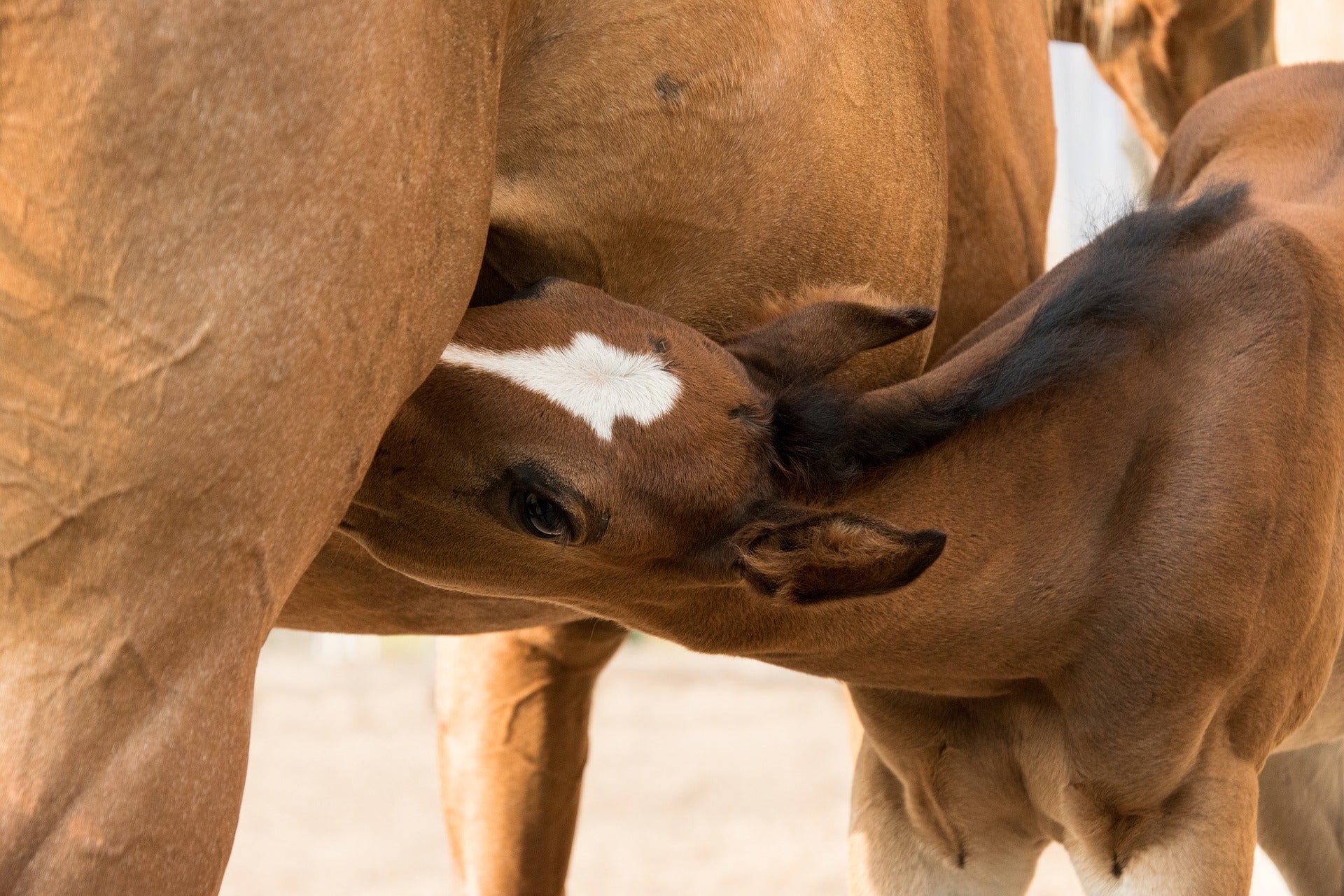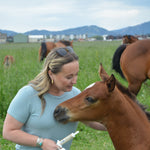Newborn Foals: When Something’s Not Right
June 7, 2020

Key Takeaways:
- The first things a healthy foal should do are stand and nurse.
- Foals are particularly at risk of developing diarrhea within the first week or two of life, which you can stave off using probiotics.
- Neonates are vulnerable to a variety of dangerous conditions, from foal meconium impaction to bladder rupture to joint ill.
Your mare has just foaled the most adorable dark bay colt. Minutes old, he’s already trying to get those spindly legs to support his slick, trembling body. Mom laps at his coat and nickers to him encouragingly.
These are all good signs – your newborn is alert, bonding with his dam, and trying to stand. A litany of problems, however, can happen with mare and foal in the hours and days after birth. Some signs of trouble, like an inability to nurse, are obvious, while others are far more subtle. How do you know when to have your vet investigate a possible problem?
How Soon Should a Foal Nurse? 3 Signs of Health
Within three hours after foaling, three signs can indicate a healthy start: a foal standing, nursing and a completely cleared placenta.
“If the foal is not standing in an hour, you need to call your veterinarian,” says Dr. Rob Franklin, FullBucket co-founder and equine internal medicine specialist.
The reasons a foal might struggle to stand are many. Because time is of the essence, however, get your vet involved rather than trying to pinpoint the problem yourself.
A newborn foal not nursing is another red flag, says Franklin, be it of his own accord or because the mare is not producing milk. Foals acquire the necessary antibodies that help prime their naive immune systems from the dam’s first milk, or colostrum. She produces only a limited amount of colostrum in the first 24 hours after birth.
“The foal needs to consume at least a pint of it,” says Franklin. And how soon does a foal need colostrum? “Well, the gut is only open for 12 to 24 hours after birth to absorb those antibodies.”
If the mare leaked milk prior to foaling or the foal doesn’t nurse right away, he says you’ll need to have your veterinarian out before the gut closes to administer colostrum from a banked source and potentially provide a plasma transfusion.
Third, if the mare hasn’t expelled the placenta entirely within 3 hours after foaling or it appears abnormal, something is amiss. Make sure you save the placenta for the veterinarian to examine by putting it in a water bucket and covering or utilizing a feed sack to store it for inspection. If the placenta isn’t healthy, shows signs of tearing, or of placental insufficiency or infection, for instance, Franklin says he’ll need to take immediate steps to treat the mare and/or foal accordingly.
Even if your foal does stand and nurse and your mare does clear the placenta fully, Franklin says it’s crucial to have your veterinarian perform a post-foaling mare and newborn foal exam within 12 to 24 hours.
During the exam your veterinarian will ensure:
- The mare’s reproductive tract did not become injured from foaling,
- That she is producing adequate milk,
- The foal is free of congenital birth defects or orthopedic problems, and
- That the foal consumed adequate colostrum by performing an IgG antibody test from a blood draw.
Trouble Ahead: Problems with Foals
Once your foal is on his feet, he’s not out of the water yet. Health issues to watch for in the first hours and days of life include:
• Foal meconium impaction occurs when newborn foals have difficulty passing the first manure. “The first stool that is passed is an accumulation of metabolic waste from throughout the gestational period, and is called meconium,” Franklin explains. “It looks like a black, tarry stool. It’s very hard, and, especially in colts, can be difficult for them to pass.”
Foals struggling with meconium impaction typically look like they’re straining to urinate or defecate. “If they are straining, then that’s the time for you to call your veterinarian and have him or her come out and provide treatment,” he says.
• Uroabdomen, or urine in the abdominal cavity, is another condition more common in colts than fillies, particularly after traumatic births. “The pressure that occurs in the abdomen can rupture the bladder,” says Franklin. “What we typically see is just a lack of urination and, over time, as the electrolyte levels begin to shift in a negative way, the foal becomes lethargic.”
Healthy newborn foals will drink and urinate a lot, and the urine will appear clear. “If you’re not seeing the foal pass urine or you’re seeing the foal pass a scant amount of very thick urine, those are signs that there could be a problem,” says Franklin.
• Neonatal maladjustment syndrome, also known as dummy foal syndrome, occurs when neonates don’t get adequate oxygen while in the uterus or during/shortly after birth, resulting in strange behavior and neurologic signs.
“Throughout that first 24 hours, you’re looking for subtle behavioral changes,” Franklin says. “Again, a normal foal is going to stand up, play around, suckle, urinate, and lie down and sleep. That process is just going to repeat throughout the course of the day. If you see a foal that appears to be sleeping excessively and does not stand up or play, its ears are flat, and has a very sticky forehead (with milk from unsuccessful attempts to nurse), these are signs that the foal should be evaluated right away.”
• Joint ill, also called a septic joint or septic arthritis, does not result from themare stepping on her foal, as owners sometimes assume; rather, it’s a sign of infection.“It’s a very common manifestation of a systemic illness where bacteria are present in the blood and invade the joints and the growth plates” at the end of long bones, says Franklin.
These are just some of the more common recognizable conditions in newborn foals.
Getting Ahead of Foal Diarrhea
Going from the first 24 hours into a foal’s first week of life, he’s at particular risk of getting diarrhea because he doesn’t yet have an established immune system or microbiome – the community of healthy microbes that colonize the gastrointestinal (GI) tract and prevent other “bad” bacteria from causing disease.
For this reason, Franklin recommends administering FullBucket’s Foal Kick Start to line the GI tract with infection-fighting antibodies on Day 1 and half a tube of Foal Probiotic Paste twice a day on Days 2-7 during the first week of life.
The goal is to set the foal up to develop a healthy digestive system and prevent diarrhea– particularly in those first few days.
While “foal heat” diarrhea is one of the more common causes of diarrhea in horses and typically occurs between 7 and 12 days of life, usually during the mare’s first estrous after foaling, bouts of diarrhea within the first week often mean something’s wrong.
“That is a sign of a systemic problem and should be addressed immediately by contacting your veterinarian,” Franklin says.
He says you can differentiate healthy newborns with foal heat from sick ones because they’re typically “bright, alert, active, nursing, and well-hydrated. You look at their mouth, and it’s moist, pink, and the foal is otherwise doing fine. We manage foal heat diarrhea symptomatically with our probiotics and prebiotics (live beneficial microorganisms and the foods that feed them) and our anti-diarrhea drench.”
“So that’s kind of a rapid rundown of foal medicine 101,” says Franklin.
Remember: Make sure your foal stands and nurses, watch for signs of common problems, and set up his immune and digestive systems for success using Foal Kick Start and Probiotic Paste, two essentials for every horse owner’s foaling kit.

